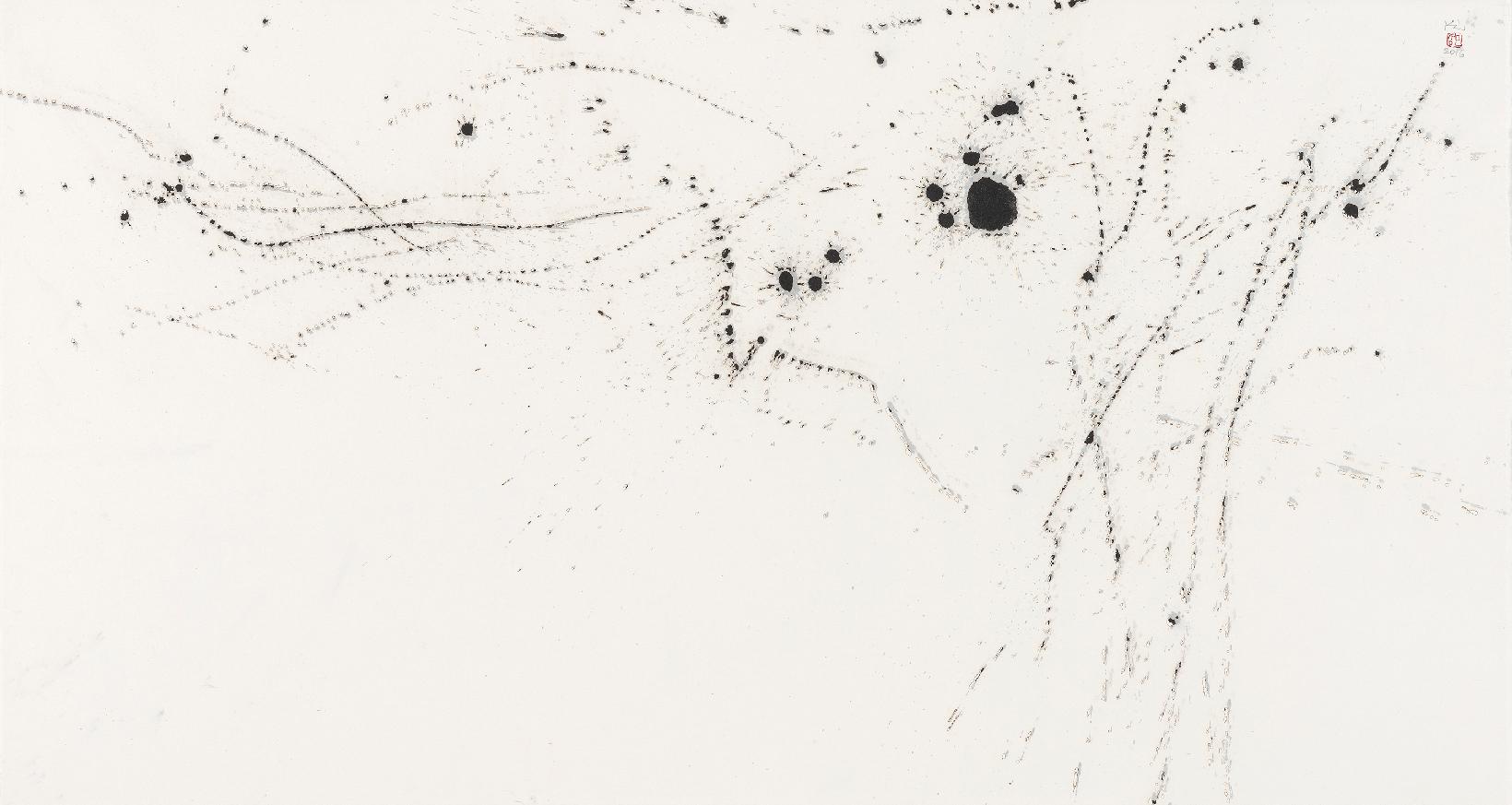
Hans Ulrich Obrist, director of the Serpentine Gallery in London and art critic, engaged in conversation with the artist Minjung Kim. In the conversation, they shared thoughts on Minjung Kim’s artistic oeuvre and endeavors.
*인터뷰 한국어 버전 읽기 클릭
Hans Ulrich Obrist : It’s such a pleasure to see you. How are you?
Minjung Kim : Me too! Finally, we have a chance to meet.
Yes, exactly. Where are you at the moment?
I’m in my studio in Saint-Paul-de-Vence.
Your life very much seems to be between geographies because you left Korea a long time ago and lived in so many places. Can you explain to me how you work and where you have worked? All these places like New York and Venice and Milan…
I left Korea when I was 28 years old and moved to Italy where I lived for 22 to 23 years. After that, I came to France and I also have a place in New York. While my base is no longer in Italy, I do have a studio in Venice though I go very rarely. I work mainly in Saint-Paul-de-Vence with maybe about two months per year spend in New York.
How did it all begin? I was wondering when you were in Korea, how did you come to art? Or how did art come to you? Can you tell me a little bit about the beginnings of your work?
When I was a kindergarten student, I participated in a lot of art competitions and always won prizes. My mom thought to herself, “This girl is talented, maybe she can become an artist.” Since then, from a young age, she made me undergo watercolor lessons, calligraphy lessons, and piano lessons. She wanted to give me what she thought was a complete education for an artist. So I did not decide this path on my own but was rather trained to be as such.
Your father also had a studio for typography and this early connection to paper is a really important childhood memory. Can you tell us about this; this connection to paper and typography?
Unlike now, there was no offset print at that time so people were doing it in the old school way. They used silkscreens, manual printing and made books too, using normal paper and very nice thin paper, similar to rice paper. There was a lot of paper being cut and the leftovers were thrown away. So I played around with the waste paper and made things out of it like cards. I played with it all the time as a child having a lot around me.
Also, craft played an important role. You grew up in the city of Gwangju and it’s a place with a lot of tradition, calligraphy, for example. A lot of these traditions are on the verge of extinction. Richard Sennett wrote a book called The Craftsman and it is a social critique about the relationship between making and thinking and about how important the relationship is. We think by making, we make by thinking. So, I am curious to know about your connection to calligraphy and craft, which again came from your childhood.
Calligraphy means you can handle the brush, which is made by the hair of animals, but when this brush is put into water or ink, it becomes very free. It is not like a pen. You handle the brush by using your arm and by learning how to focus and concentrate. With this focus, the brush becomes very much like a pen. I think it is more about focus rather than craftsmanship for calligraphy. It is about learning how to use the brush. Normally, you write calligraphy with black ink but after the writing, the ink is diluted with water and it becomes like a scholar's painting depicting the old stories. To do calligraphy, you know how to handle this material and it is important for Asian art.
Also, it’s about the quality or dimension of slowness in craft. As Richard Sennett wrote, “Our modern economy privileges pure profit, momentary transactions and rapid fluidity. Part of craft’s anchoring role is that it helps to objectify experience and also to slow down labor. It is not about quick transactions or easy victories. That slow tempo of craftwork, of taking the time you need to do something well, is profoundly stabilizing to individuals.” It is interesting because I think this “slow tempo” is stabilizing to individuals. Sennett said that craftsmanship is an “enduring, basic human impulse.” Can you talk about that? Because it seems like an important part of your childhood compared to our accelerated world today. When I read your interviews, your childhood seems to be much slower.
Oh yes, because at that time Korea was still rather undeveloped and we lacked sophisticated machinery. Things were made by hand, especially in the countryside areas. So, in hindsight, the paper-related works that I have done would have been considered normal under the circumstances of that time and our economic development per se. Now, while I still apply these crafts, I feel that we all have our speed which is the most natural speed and it is good to keep it despite being vulnerable to the speed of others.
The future is often invented with fragments of the past. You have studied a lot about the past; about the history of calligraphy and ink-painting. Can you tell me about what you have learned regarding the history of calligraphy and how you used this history later on for your work as there are different histories of calligraphy such as the Chinese histories and Japanese histories? But it is specifically Korean calligraphy, which has a very special and unique identity. How important was that and what did you learn from these calligraphy teachings?
What you learn first in calligraphy is how to use the brush. When you become proficient, you can choose and write a sentence that expresses your emotion or state. From this point, one can distinguish whose work it is because the calligraphy became pictorial. Therefore, to have your character, you need to master everything. When it comes to myself, I learned and I saw a lot of Chinese and Japanese calligraphy. We always start to practice calligraphy with the Chinese character and the character itself is very pictorial. So we naturally use the brush to draw the character. What you have to do is keep practicing until you attain certain proficiency. It is like playing the piano. For example, you are practicing Bach. Before you play, you need to train your hands. For me, practicing calligraphy means training my hands for the next step.
Do you still have some of early works you did as a student in Korea? What are your earliest works? I am always interested with artists where they begin in their catalogue raisonné. What would be your number one entry in your catalogue raisonné?
The earliest work is when I was in Hongik university. It was also a very colorful and realistic one like a Japanese painting. One of my professors was specialized in Japanese painting. At that time, I really liked to paint with Japanese materials, such as powder color, which is used for realistic painting. I started with the landscape, portrait, and figurative works.
Are those earliest works preserved in a way?
Yes. I keep all of them, of course.
What prompted you to leave Korea? Because it is interesting. I am from Switzerland and Switzerland is a small country. I think when you come from small country, the idea of the impetus to leave is quite strong, because there is a certain narrowness. Nam June Paik always told me about the necessity for him to leave Korea. I want to hear it from you. After the master degree, you traveled, then came to Milan and entered the very famous Brera Academy. What prompted you to leave? Was it sort of following the traces of Nam June Paik?
It is a mixture of my personal life. Since I was young, I had a very ambitious dream to be a well-known artist. I wanted to have my own big career. But I realized it is difficult when my country did not have an infrastructure. I always dreamed more of Europe than America. At that time, all of my colleagues went to New York. But I especially loved the European Renaissance period. So, I decided to go to the birthplace of the Renaissance. Also, I like Flanders art and Italian art. I still think proudly of choosing Italy as a starting point.
In which year did you arrive in Italy?
1992.
Indeed your work has changed. At first, it was the early influence of Korean art and then you went to Italy and studied the Renaissance. You are also very much into the history of modern art, Kandinsky, or Paul Klee. I am from Switzerland, so Paul Klee was a big childhood influence for me … for example to make the invisible to visible. So, the East and West seem to mix, they seem to come together.
Yes. When I went to Italy, the school was very passionate about photos, videos and performance. I felt like I was out of place and wondered if I could go along with the school and its curriculum both physically and internally. I was losing my confidence. What can I do here? What I only know is calligraphy, watercolor painting, and technical figurative painting. I was depressed because I flew there so far away and I felt completely lost. Then I met my professor, Maurizio Bottarelli, he said “Why don’t you paint the spring but abstractly.” Then he gave me some clues, make artwork with watercolor stains and try to be free because he thought I was too academic. I was trained slowly with abstract painting, mostly with watercolor and rice paper. During the academy of Brera, even though I couldn’t find my way, I tried. After I finished my studies at the academy, I started to work with quite a big gallery in Milan. Since then I have tried to mix my observations of the West and my skills with the brush. I am still doing a lot of collage with burned paper. My time at school lasted five years, but the assimilation to find my way took another 15-20 years.
You began with calligraphy and more traditional work in Korea, and then you came to Italy and started on the Renaissance, the 20th century, and you said that “it takes some time.”
I do lots of different series of work overtime. But I think my Mountain series is a good combination of traditions and abstraction. It is something where I combine the tradition and Western influence in simplification. For the work called Pieno di Vuoto, I took all the paper, cut and burn them and made a colorful collage. I felt that it was truly symptomatic of my originality or “language” to put it another way because I have not seen similar works in any other places. For that reason, I would say it is these two works - Mountain and Pieno di Vuoto.
You have actually described the mountain as something rather impermanent. We often think of mountains as permanent, but you have described it as impermanent. You have also said that it has got to do with childhood memories. Etel Adnan wrote the book Journey to the Mount Tamalpais, which is kind of a tribute to the Mount Tamalpais, and at the same time it is also a memory of the mountain in Lebanon where she grew up. It is a book “of time, self, impermanence, the nature of the universe, the spiritual dimensions of art….” Basically, Adnan has said, “When you realize you are mortal you also realize the tremendousness of the future. You fall in love with a time you will never perceive.” Maria Popova wrote a very good review of this book Journey to the Mount Tamalpais. Adnan, who is now in her mid-90s, still talks of the mountain as her best friend. I suppose your mountains are also your friends, they are like memories from your childhood. Where do these mountains come from and why are they impermanent?
I miss my country very much and this is why I paint the mountains. The mountains in my painting are not specific mountains that I have been to. Once, I met some Korean people and they said “your mountain must be Jirisan Mountain!” Actually, my mom lived there for 3 years, but I have no memories of the place. Interestingly, I paint something that looks like Korean mountains, it is different from the Dolomites and other mountains in the West. Mountains formulate formless things such as your origins or feelings. The feelings that you are in somewhere fixed. I cannot explain why I have done this or why I have so focused on painting mountains. But I still do the mountain works and think of it often. Painting mountains is like gripping my national roots.
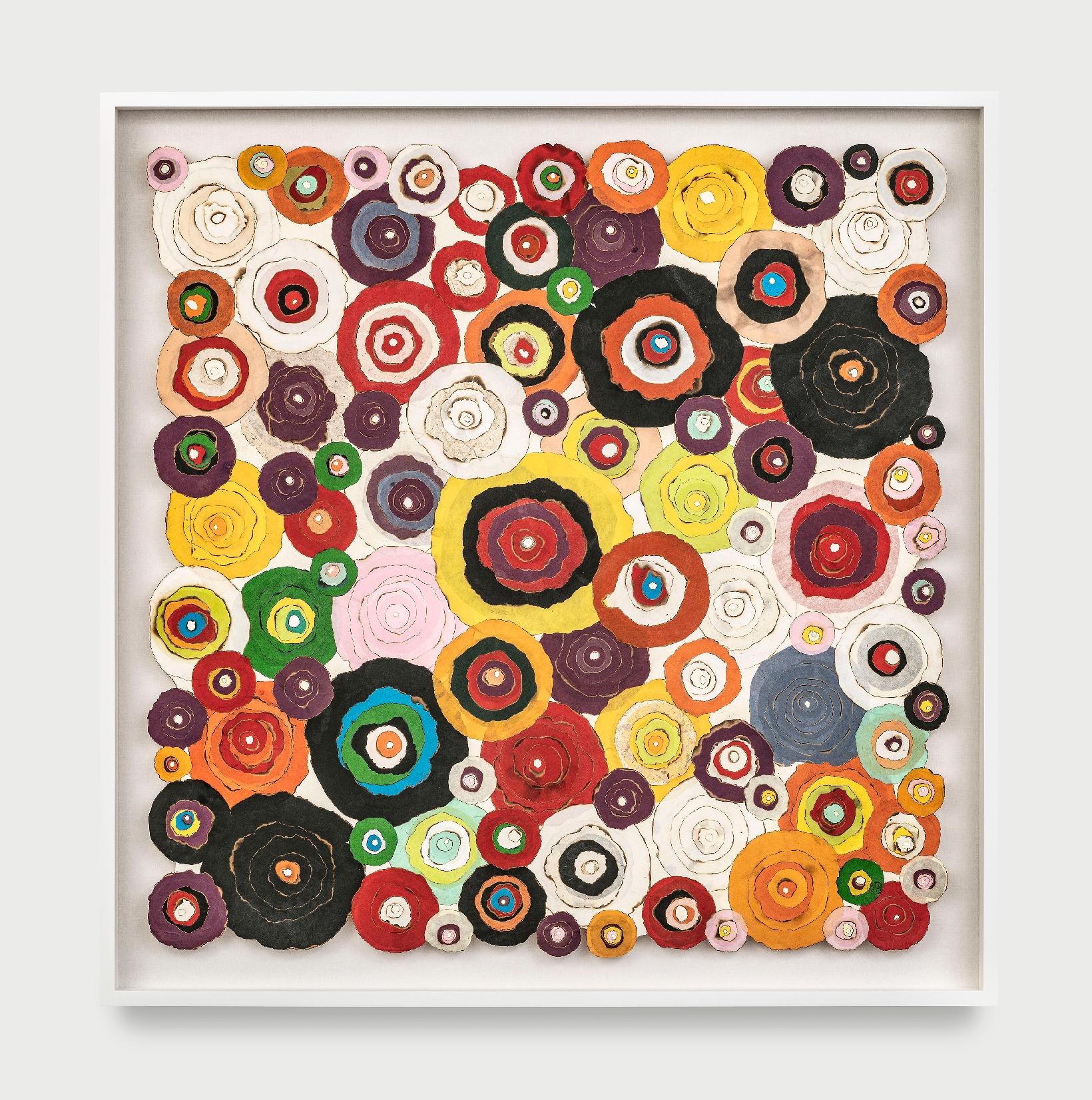
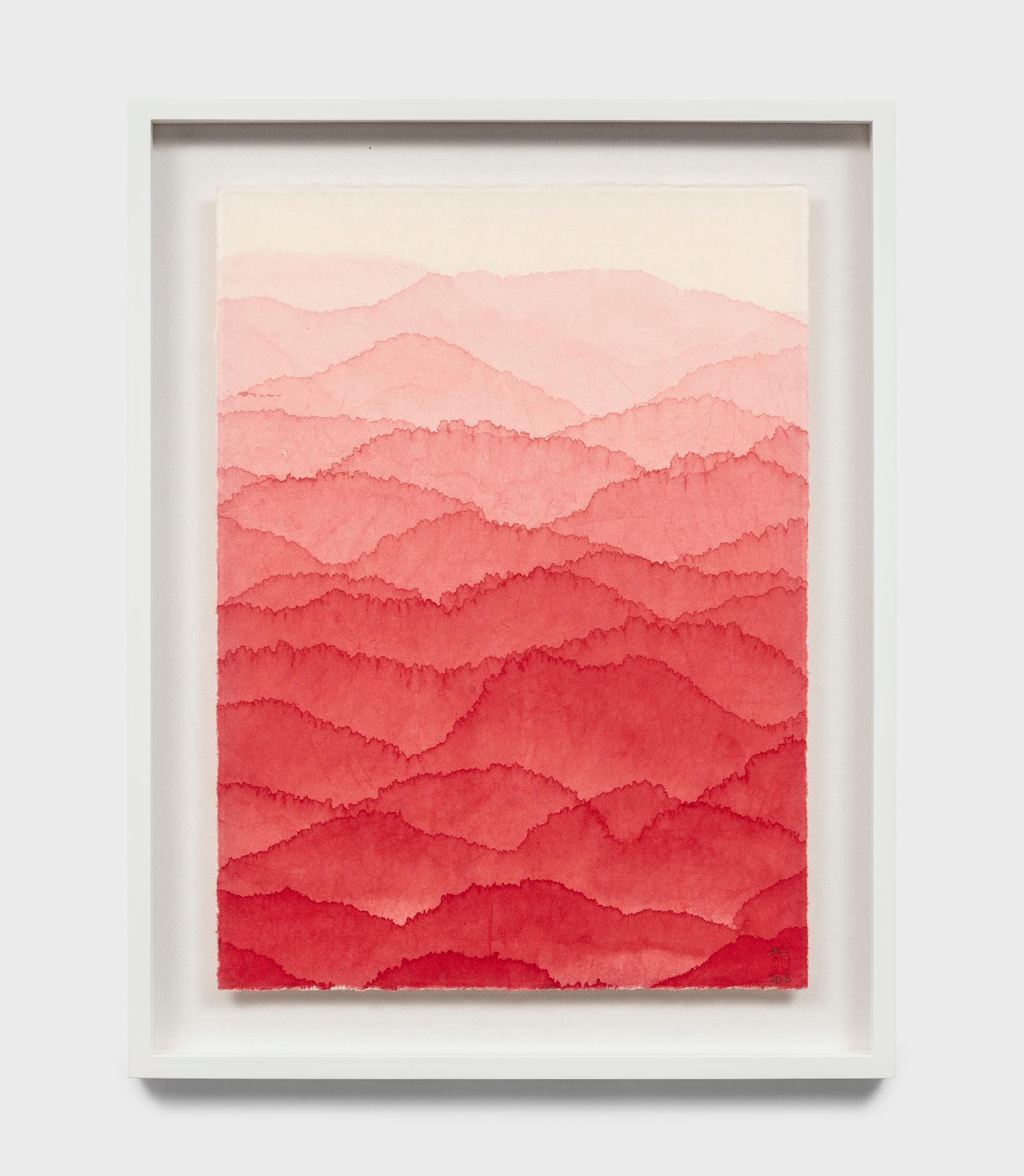
You use paper for the Mountain series and the use of paper is constant in your work. You always use the mulberry hanji paper, making collages and also for many different things. The Eastern paper which is not only used for the traditional Korean calligraphy but it is also used for all concepts of all of things, for example, it is used for the floor and the windows in the traditional houses and it is used for the printing press. Can you talk a little bit about why you use of this incredible paper from the mulberry trees? And the paper is never twice the same, every year, the paper is different.
Yes. In my university in Korea, you have to learn various materials such as sculpture and printing in the first year until you can later choose the specific department that you want to specialize in. Of course, I chose the Department of Oriental Painting, in which you learn how to deal with traditional materials. I chose this because I wanted to continue what I have done from a young age. Hanji paper is transparent, delicate and easily destructed but it is resistant. Someone might feel that it is like him/herself or his/her character. And also, I think the material should be the thing that I could easily handle with my strength. If I was a sculptor, I could not carry big rocks or heavy materials. I would always need somebody’s help. I want a material that is completely synchronized with my skin and body. I feel the material becomes a part of myself. Paper is my skin. I feel so intimate and familiar with this material. I have been dealing with the paper for almost fifty years since I was so young. I feel so comfortable with this which is why I chose it.
You use it not only to draw or not to paint, but you also use it in a collage and you glue the pieces of paper with Korean rice glue. It is like a palimpsest of many layers. When did you start that? How did you come from the paper of the mulberry trees to the rice glue?
Paper is normally used for calligraphy, and it is brought to the traditional frame-maker. They put another paper behind the calligraphy to make it flat and more substantial. For this, they use glue made from flour or other natural materials. It is called rice glue or starch glue. I make my own starch glue. This glue is pasted very thinly. Normally it is used to fix the two paper layers but when I started cutting and burning paper works, I wanted to try the traditional glue. I have been working on paper for so many years and I got a bit bored with painting. Then I invented the method of burning the edge of the paper, which creates a natural line, and it was what I was always looking for. Things happened very naturally, one by one and step by step. And now I am here, making the layers of paper. But I have never planned this. It was not about thinking about what to do. Everything was going on very naturally.
You have also described this natural process. As a process of repetition and it is relaxed but it is also very dynamic. You use this idea and image of the biodynamic. Can you talk a little bit about the actual process when you assemble these little pieces of hanji paper in a very calm but also biodynamic way?
Basically, not only being an artist I always want my status as anima to be very free and to be in line with the natural order. To reach this position, some practice or training like meditation or yoga. For me, repitition means losing yourself and going deep inside yourself. Of course, the result of the artwork could be beautiful in many different ways but doing this is more important because it makes me lose myself. I feel that it is the way of practicing Zen or meditation. Once you start to repeat for hours and hours you completely lose your circumstance which I like because I feel so cleansed. This feeling is addictive.
Do you know at the beginning where you will go? Because I read in interviews about your Phasing series, you talked about the empty sheets of paper, where you draw abstract calligraphic signs and then it dries and then you lay out a sheet on top of it and start a long process of copying with a pencil. You draw outline of all the shapes and tiny ink spots form on the underlying sheets. Then with a lit incense stick, you perforate the second sheet, so as to reproduce the drawing on the first sheet. So, it is a very complex process in the Phasing series. But it always begins with an empty sheet of paper. Can you talk about this process?
The Phasing series analyzes ourselves. The process of painting is fast and virulent. When I do this, a powerful and brisk part of me activates, and so to say, it is a masculine part in me. But we have opposite sides of our character that we cannot divide. Another part of me is more precise, more reflective in a completely different way than the first. It is the opposite action. Two pieces of your character meet at one point and these two parts make one thing. When I put both sides together, it makes a unification. So after this process, you can see there is a time difference and there are two intentions that are different. Once these opposite characters unify as one it makes a more complete portrait of ourselves.
What is the role of chance? John Cage talks about chance. I saw this video you did for the Brooklyn Rail where you said about Order and Impulse. You could never plan it, and art is not planned because when you are folding you do a mode of impulse but it is very much ordering what I am doing. So basically, two opposite sides of our actions. So there is something to this. Alighiero Boetti talked about order and disorder. It seems to be something to these impulses of order and disorder – of planning and chance. Can you talk about that? What is the role of chance and to what extent can you plan it?
It’s already very ordered when you cut the paper into round shapes but the moment when you are folding, you can make different directions. So the last moment when you decide how to fold is the chance. Through the different ways of folding and making different directions, you are going for harmony somehow. But it starts without an order. You fold it impulsively and there is no rule at the moment. So again, it shows the two different characters to make this artwork.
In the same interview with Brooklyn Rail you said “Why I have done it? Don’t ask me. But then I like to do these things because by doing these things you lose yourself. Finally, I lose myself.” The idea of losing yourself in the making of the work is interesting. Because in another interview with the Musée des Arts Asiatiques you said “To do this work, according to paper, you have to empty the mind, to not have any thoughts, to fix your gaze on the fire. For me it is an act of meditation.” Can you tell me about that and about losing yourself?
I always think about what I have planned or have intended artificially by my own. I also think that a human ability is limited. We can never achieve something beyond our intellect. As long as you don’t lose yourself, there is no chance to capture the rule of the universe because ourselves is so limited and full of prejudice. Even if I use my intellect, I can’t go so far. I am curious to know if myself is a medium for something to come through and I make art. If I use my ability, it would be so limiting, but losing myself means that I give more chance to get a visit by, I don’t know, spirit or inspiration or something bigger than myself. I can be the medium for something to come through to make art. I don’t know where it comes from but I hope to continue to be free to receive it.
The idea of chance is also connected to the fire. Because you tried to find what kind of lines you could do. Actually the line that would define your practice. So, you thought of having this particular line that you borrowed from a supernatural force and that supernatural force is the force of fire. Fire is dangerous because it could burn you but you use that fire and it’s interesting as there is chance in the fire but it is a very “controlled chance” and you call it a collaboration. Can you tell me about the fire collaboration?
The most powerful destroyer in the world is water, and of course, fire. The fire has such a strong power but I am using thin paper with the fire. The power of fire could kill the paper immediately. However, I am in the middle of the two and I make them help each other to make some form. So I like to use this superpower to join the most delicate human invention like paper, being myself in the middle. Just being in the position is a privilege.
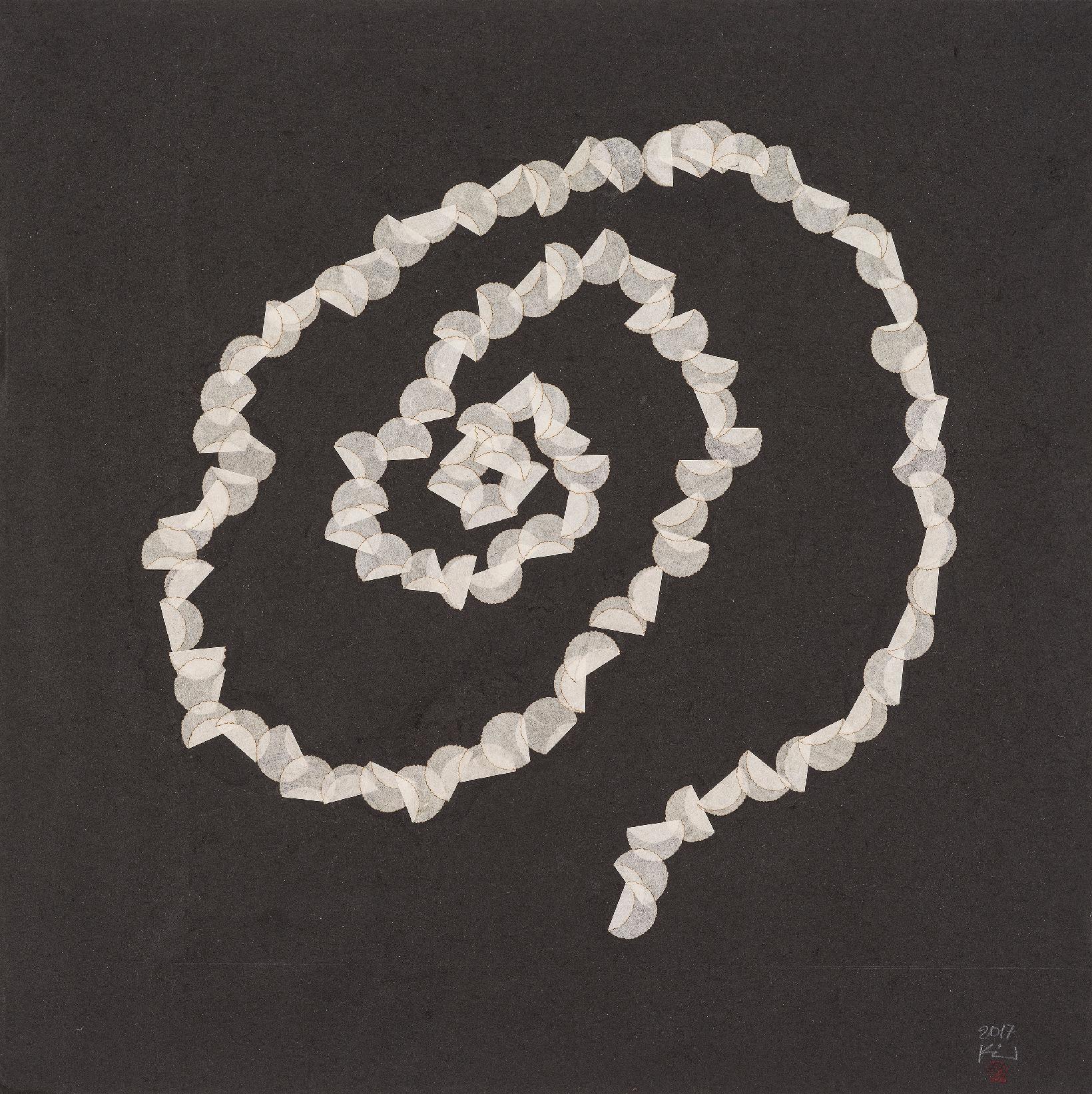
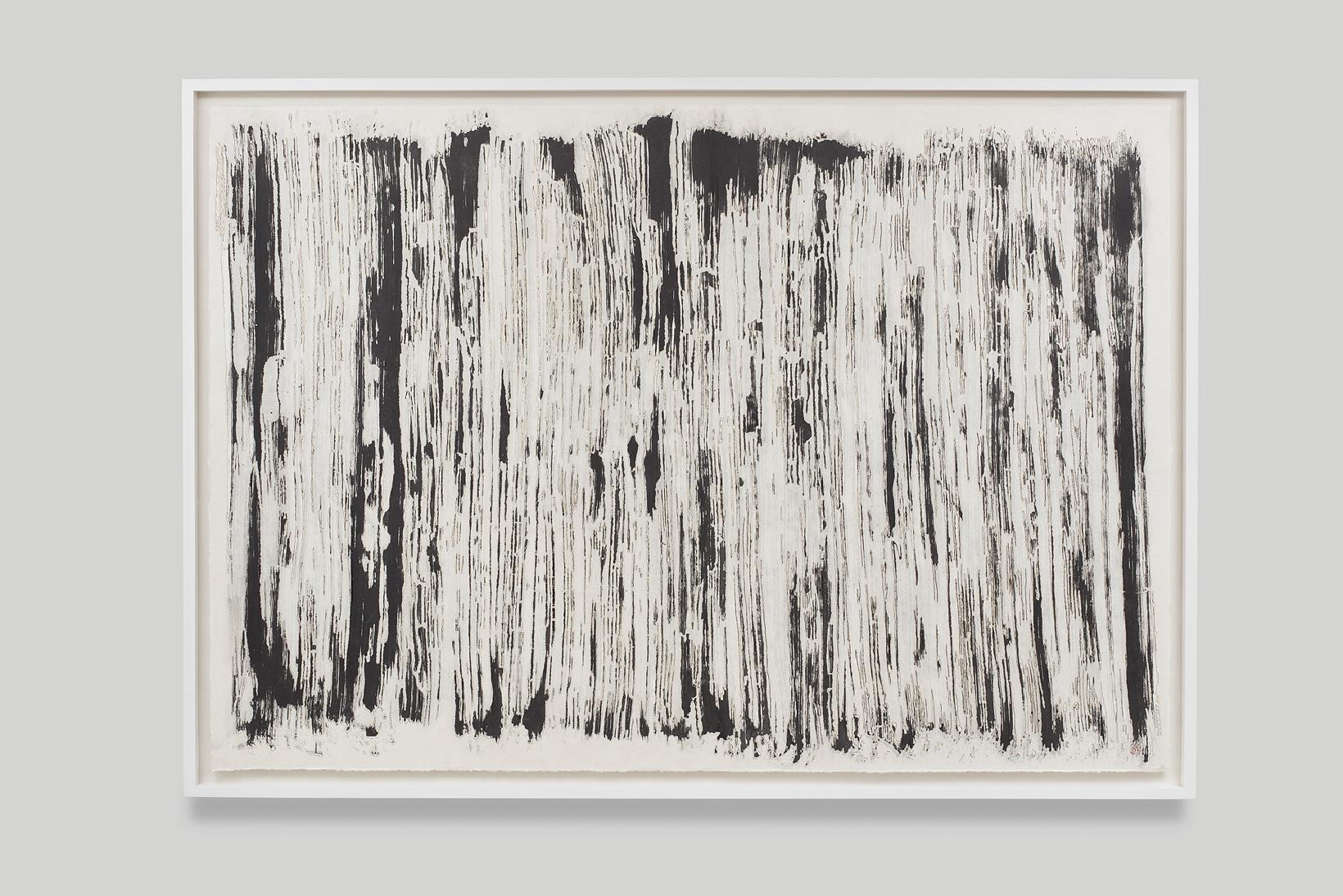
We are talking today for your new show at Gallery Hyundai in Korea. This is not your first show with the gallery, you did one in 2017 called Paper, Ink and Fire: After The Process. I was re-reading Lorena Muñoz-Alonso’s review of the exhibition and she wrote about the constraints in your work. I worked on a book with Harry Matthews and I was always very fascinated by Georges Perec. The Oulipo poets of France have always been very important to me. They are pioneers of the study of the constraint in literature. Georges Perec wrote a novel without the letter “e.” So it seems to be a prison or closure but within there is a lot of freedom. So, you decided to focus this show exclusively on paper, on ink and on fire, and that has been over thirty years.
Yes, whilst you are using these limited materials, constraints as they are, necessarily you become a master of these materials and then you become free and you do not hesitate. These days, young artists do not think about the nature of what they are using as materials. In my case, by placing constraints like this to limit myself, I become free and a master of them. It became easier for me to express myself with these constraints. Because you know what you are doing and you know what the technique could be.
At the same time, there is a color. You do use color sometimes. For example, Story or Pieno di Vuoto. Can you talk about that?
The result of Pieno di Vuoto looks full of color but to do this, I create a round shape by cutting paper and make a hole in the middle like a donut. Then I burn it on both sides and start to build it one by one on top of these circles. Basically, I am using vuoto (void). I make a hole in the paper representing emptiness. And with this emptiness, I put it all together then it becomes full. Full of the Void, Full of Emptiness. That’s how the title came. Yes, it is very colorful but it has come from Buddhist theory – the world looks like full of color but the color itself is empty. The form is the emptiness, and emptiness is a form. For my work, form represents the color. So basically I interpret with my materials. Pieno di Vuoto is my interpretation of the theory founded on Buddhist philosophy.
You have incredible teachers, Buddhist teachers that practice Zen and meditation. You once said that they taught you a theory of opposites. Such as yin and yang, black and white, there is always an opposite so it creates a tension, a balance. Can you talk about that philosophical aspect of what you have learned from this? And also, who are these Buddhist teachers?
In Asia and in Korea, many Buddhist monks or those who learned Buddhist theory practice calligraphy. My calligraphy teacher who has taught me from a young was a Buddhist devotee. I learned Buddhism theory from her. With those lessons in mind, I interpret these lessons to match my circumstance. Buddhism gives me a lot of my life tendencies as well, not in a practical and literal sense, but I live with Buddhist philosophy. And as you said, there are two opposite things like yin and yang. They have tension and it produces a phenomenon. Both in the East and West, there are similar concepts of the two opposite things, two becoming one, or one becoming two. It is easy to apply it to my artwork and I always ponder over such thoughts because it is a philosophy from which the meaning of life is derived.
In the exhibition which is going to open from February 2021 in Seoul, you are going to show many different series. Mountain, Story, Timeless, Sculpture, The Street, Pieno di Vuoto, Order and Impulse, and a new series called Couple will be introduced. Before we talk about the different series I want to ask you about how it came that you always work in series. There is a strong presence of series from the beginning of your work, and these series do not seem to stop. It is fascinating that you continue to do this over many years for example Story and Timeless. These series have been going on and I don’t think they appear to be an end in sight. You will probably continue them in your life. Can you talk about that? Because artists do a series, and when it is finished there is a new series. But for you they seem to be ongoing.
Yes, exactly. I put these titles but essentially my artworks have the same meaning in the end. The appearances look different, so I give different titles. I like to give titles because it is like naming a child. However, the reality is that these works essentially have the same meaning. Some are just paintings and some are paintings with burns and glue. With respect to that, it can be a bit monotonous when you keep working on the same series, but giving different titles can provide an alternate narrative. So they are ongoing and the same thing after all.
We already talked about Mountain. I want to ask you about Timeless series because you are interested in the stratification of time. You can produce two-dimensional work, three-dimensional work, 4D, 5D, maybe even more. Maybe you can give them 11D. Can you talk about these dimensions and how it led to the Timeless series?
Basically, the Timeless series came from the Mountain series. I never wanted to paint mountains initially, but rather the “sound” of the tide of water and the sea. I first started painting tides of water in the sea. Suddenly I feel that this resembles more mountains than tides which resulted in the change. But the “sound of the tide” implies a million times that the water never stops “coming and going.” So, for me, the sound of the tide is a timeless phenomenon. After I changed it to mountain, I cut the mountain painting and burnt each side of the paper pieces, and glued them. Finally, I created a sense of the tide but in an abstract way so that it is endless and timeless. They are simple and minimal waves but I get the feel of the tide and the timeless effect.
There is also another series called Story and that is also a series which have been going on for a while. Again, you use mixed media on mulberry hanji paper. What was the inspiration for the Story painting?
The inspiration of Story was derived from the huge library in my studio in Milan. One day, I was looking at the library and I realized that when books are fully stacked side by side on shelves, they appear very colorful, like an abstract painting. I started investigating each book; its volume, nice colors, and what is inside the book. We record our thinking in the book and it becomes a story, and my bookshelves contain many of such “stories” that can be focused on. That’s why I started this work, with each small piece of paper representing one book. Books make a story, so I came up with this title.
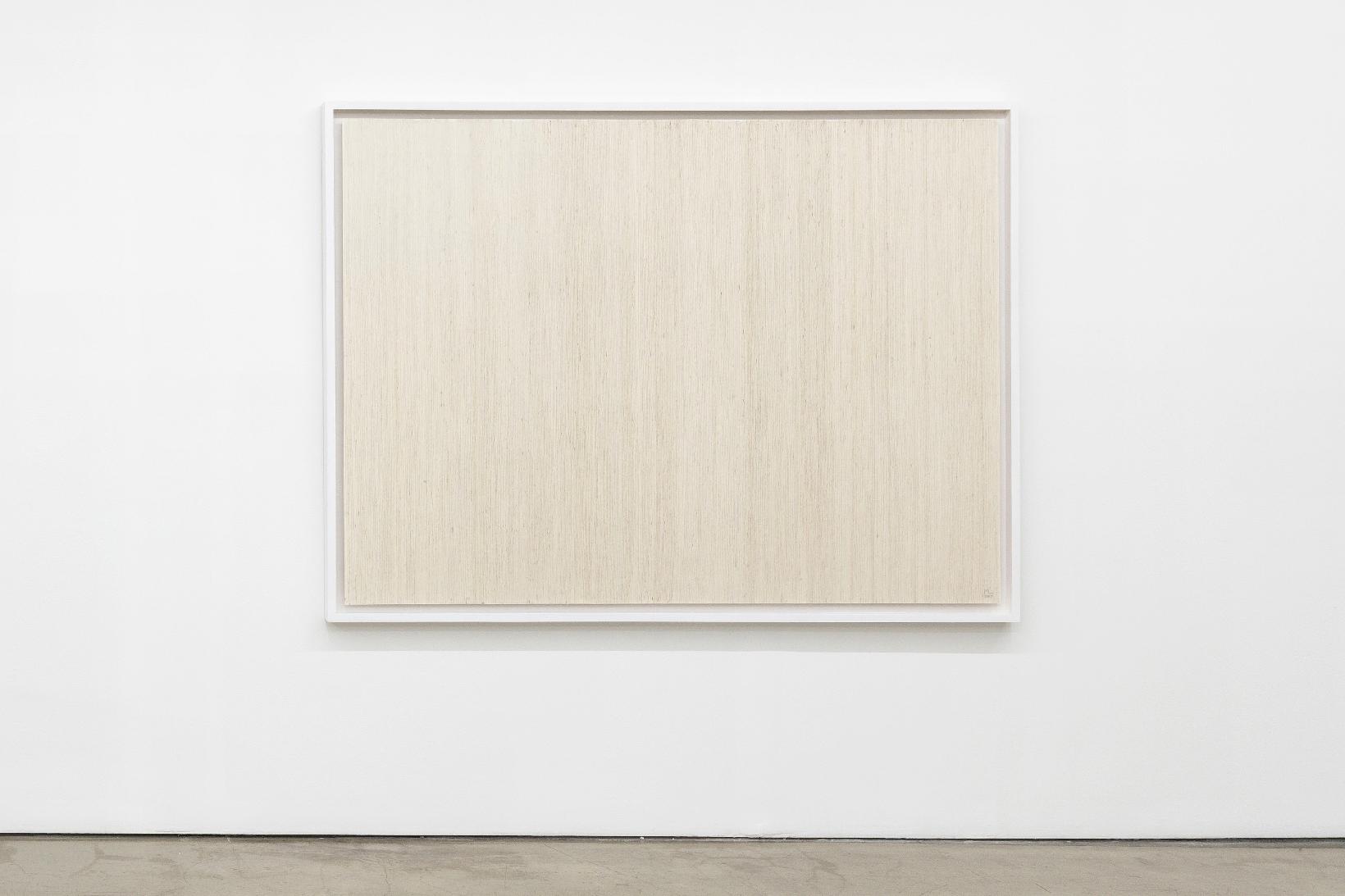
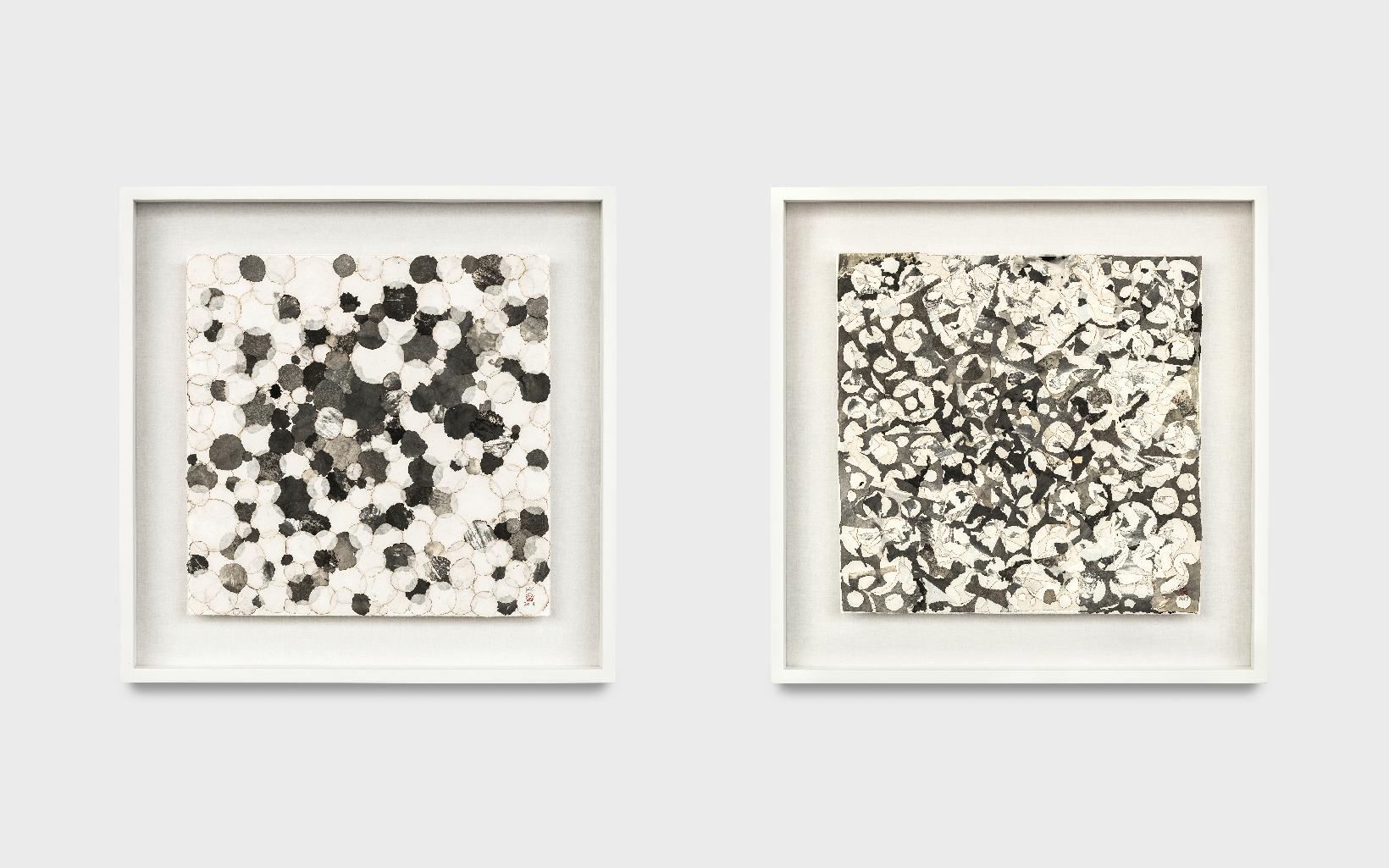
Then there is Sculpture, which is interesting because sculpture has a lot to do with the way of using fire. These works are some sort of 2D but then sometimes you go into 3D like Senza Gravit in 2007, with the enamel. Also, when I think about the work The Room, sometimes you even go to three dimensions. Can you talk about that?
Yes, as a painter, of course, I am dreaming or curious about a sculptor making three dimensions. So I am constrained with this material but thinking of how I can make a sculpture with my paper. I made a simple form and repeated it just by gluing in the same distance, and it became like a form of a tire. In The Room series, I make lines to give a space. It was a trial. It was an experimental process. I did not know if I succeed or not but I wanted to test what I cannot do supposedly because of the limits of my material.
And The Room again, it goes into 3D in a way and it was actually prompted by Osho also known as Rajneesh, the Indian mystic and founder of the Rajneesh movement who actually passed away in 1990. You read a book by Osho about different meditations. There is the idea that you are floating in the room and defying gravity and it seems that this has been influential for this series.
Yes. When I read this book, he explained that if you meditate successfully, sitting in a room, you will achieve two different results. One, suddenly your own “self” becomes very big so that your room becomes very small. Second, it is the levitation of yourself. So you will fly to the top of the ceiling and see where your body was. I imagined if I reach this moment and I see my room, levitating. That is why I draw like this without a realistic dimension but just with hand drawing. This is The Room and the book gave me this imagination.
It seems that layering is also at the center when you go from two to three dimension. For example, for your sculpture like Senza Gravit in 2007, you layered enamel with stacked sheets of glass. The layering creates this kind of 3D effect. Senza Gravit is probably your most sculptural work.
Senza Gravit is the only sculpture I have done. I put each flat sheet together to make a shape. By creating an optical effect, you can observe this round ball form which is contained within the lines caused by layering. You might think there is a form with a wave but in fact, there is no form of a wave. Sense of gravity was my aim. I have been suffering throughout my life because my body gives me headaches. If we don't have a body, I believe our true self is the spirit. But since we have a body, the weight of our lives becomes heavy and it makes us suffer. So I dreamed that I exist but not exist … with a form but without gravity. That was my approach.
We haven’t mention much about The Street. Why do you call it The Street?
As you have noticed, I draw my inspiration for my artworks in many different ways. For The Street, I was just sitting and imagining that I was in Thailand. I was in an old house, maybe on the third floor, and I look out to the streets and saw women with umbrellas. It is just a pure imagination. The inspiration was from this street scenery with many umbrellas. At first, I made a very spherical shape like an unfolded umbrella. But after a while, I focused on disfiguration by making it more oval. On itself, it gives an organic form but I still give my original imagination of the street and the narrative.
You have an important project which is outside of the gallery and museum, that is your “garden” as a mini farm. I am very interested in your garden because at the moment a lot of artists are interested in farms; Otobong Nkanga is doing farm work in Nigeria. And you have a garden and farm, chicken with fresh eggs, strawberries, lambs. I saw a lot of footages online about your garden. Can you talk a little bit about that?
I like to produce something. And the product of nature cannot be made artificially. For example, I have to wait for six full months to have tomatoes or fresh eggs laid by chickens. It is about learning to wait, to not rush but let nature runs its course. Witnessing nature tames my temper and re-conceptualizes speed. Nature’s speed is different and slower, so it calms me down a lot. I love to grow food. I think it should be normal for every person. I don’t have a real farm but a garden instead, and instead of growing flowers I grow food: edible vegetables. I noticed that vegetables can still be beautiful, like flowers. Also, I feel proud of offering fresh produce from my garden when my friends come over for dinner.
You have eggs, fresh eggs every day.
Yes, fantastic.
Now, a few last questions. You are premiering in this exhibition a new series, which is called Couple. Can you talk about what prompted this series? What was the trigger and why do you call it Couple?
When I cut the paper into a circular shape there is a leftover. While I used the circles for my work, I saw the leftover paper that I was supposed to throw away. But, I asked to myself, “Minjung, this comes from the same paper and why the circle has been chosen and the rest left has to be thrown away?” So, I started to give more affection to the leftovers and made two works. One is chosen, one is left. They are the same work in the same size. I read somewhere that “couple” means that when they are separated beings the edges fit together to make one sheet. But if you take them out from the one sheet, they exist as such different forms.
I am very interested in unrealized projects. We know a great deal about the unrealized projects of architects, as they regularly publish them. But we know very little about the unrealized projects of artists. I want to ask you to tell us a little bit about your unrealized projects, maybe projects that were too big to be realized or too expensive or simply too time-intensive. Or even projects you have not dared to do yet. What are one or two of your favorite unrealized projects?
I would like to create a huge space with all my Timeless works, like wallpaper, and when you enter the space you feel the essence of time immediately. It takes 6 to 8 months for some works, and some take years to complete as they are layered one by one. Maybe one day in the future, I have my small museum, and I could create something like this. Another idea is derived from one of the sculptures. I tried for an installation in Venice where each sheet comes up one by one above the water and then goes down again. They appear and disappear like an illusion. But, when I tried it as it was saltwater, the machine could not operate for long. So, I would like to try to make some public work with the water and the form of the sea that comes up and submerges. This would also encompass a lot of my work philosophy.
Rainer Maria Rilke wrote a beautiful book with advice to a young poet. I want to ask you what would be your advice in 2021 to young artists.
As I have repeatedly said, young artists have to choose proper material which they feel comfortable with. It can be metals, paper, or ceramic. Once you choose your material, you need to develop it and practice to master it. Being an artist is very difficult. It is to manifest your thinking into a form of art. Projecting your idea with a material that you do not have mastery of would mean that you can never succeed in expressing yourself to the fullest possible extent. It is important. You will find an ideal material if you keep trying out various materials. After this, you will be able to express things fluently through your material.
Dan Graham said “You can only understand an artist if you know what kind of music they are listening to.” I want to ask you what kind of music you are listening to?
I listen to a lot of classical music but also contemporary music. I also love to listen to percussion. I think percussion gives me a starting point for attaining all my rhythms. Rhythm is more important than melody. It is a fundamental element. When I listen to percussion music, my whole world becomes clear.
The answer you just gave is a beautiful conclusion to the interview. This is my last question, which is earlier in the interview you spoke about writing, you write down something. I want to ask you if there is writing by you about your work, or if you write poetry?
Yes, I write a lot. I am a very emotional person. I am all on my own, living a single life. I have no one to discuss with so I write my thoughts down like talking to someone. Writing is a sensitive work, sometimes it is very romantic but sometimes it is depressing.
Do you write poetry too?
Yes. Also a lot of essays about what I learn. Not really poetry, more like essays on researches and findings. By the way, I am sure you speak German. You know what Sehnsucht means?
Yes of course, it means a longing.
Yes! This word very much represents myself in this period.